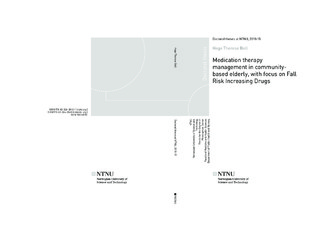| dc.description.abstract | Background
Research shows that one third of home-dwelling elderly above 65 years, and half of those above 80 years fall at least once a year. Injuries caused by falls often lead to longstanding pain and disability, and are one of the leading causes of death in elderly. The underlying causes of falls are multifaceted, but advanced age, certain diseases and cognitive impairment increase the risk of falls. Fall Risk Increasing Drugs (FRIDs) have also shown a significant impact on fall risk. FRIDs mainly comprise psychotropic drugs, but also include some drugs affecting the cardiovascular system. In Norway, projects of inter-professional medication reviews performed by team of physicians, nurses, and pharmacists have been established in many municipalities. Results from these medication reviews have shown that many elderly do not receive optimal medication therapy. The most common drug related problems reported from such interprofessional medication reviews are: unnecessary drugs; need for additional drugs; and lack of monitoring of effect. Little is known, however, of what the different professionals participating in inter-professional medication reviews learn. Little is also known about whether prescribers and patients relate the use of FRIDs to the risk of falls, and what consequences this might have for the prescribing, use and the follow up of FRIDs.
Aim
The overall aim of this thesis is to investigate how both health personnel and community-based elderly drug users perceive medication therapy management, with a distinct focus on FRIDs. The three studies were intended to:
1) explore the situations in which GPs associate drug use with falls among their elderly patients, and the factors influencing prescribing and cessation of FRIDs (Study I);
2) explore how home-dwelling elderly FRID users perceive their fall risk and how they relate this to their drug use (Study II) and
3) describe what nurses and pharmacists perceive to learn from participating in interprofessional drug reviews in a primary health care setting for up to two years (Study III).
Methods
For this thesis a qualitative methodology is used exclusively. This involved semistructured focus group interviews in study I and study III, and individual interviews in study II and study III. In study I, 13 general practitioners (GPs) participated, distributed over two focus groups. In study II, 14 home-dwelling elderly FRID-users between 66 and 97 years were interviewed individually. In study III, 13 nurses and two pharmacists participated in five focus group interviews, while two pharmacists were interviewed individually by telephone. Systematic text condensation was used to analyse the transcribed audio files from a digital recorder. All studies were conducted in Central Norway in the period from 2013 to 2016.
Results
GPs and elderly both said they did not perceive the use of FRIDs as a prominent risk factor for falls. The GPs also spoke of an uncertainty about changing prescriptions of FRIDs to whether the change would result in an improvement or worsening of the patient’s health condition. Other factors said to affect prescribing or cessation of FRIDs were: lack of suitable guidelines for multi-morbid elderly; time constraints during consultations; patient’s demands for prescriptions; and lack of clinical information of the patient. The GPs usually renewed the prescriptions of FRIDs without change, unless the patients reported dizziness or a fall episode.
The elderly reflected less about whether their drug use was related to falling or the experience of dizziness. They expressed, almost without exception, that they fully trusted their physicians and the medication therapy given by their GP. Dizziness and/or unsteadiness were generally perceived as signs of aging, rather than as potential side effects of FRIDs. There were, however, elderly FRID users reporting that they struggled to get their point across when contacting their physician about a potential side effect. Through participating in inter-professional medication reviews over time, the nurses said to learn how to interpret and link the patient’s symptoms to the drugs in use – both effects and side effects. The pharmacists responded to the nurse’s crucial role in providing clinical information about the patient, so that as clinical pharmacists, they could provide better and more individual-based care. When the three professions of physician, nurse and pharmacist worked together as a team, the nurses perceived the pharmacists as challenging the physicians in other ways than when only nurse and physicians performed the medication review. The nurses said the pharmacist’s presence forced the physician to reflect and argue for their previous medication therapy choices in a more comprehensive manner.
Conclusion
The GPs did not perceive FRIDs as a prominent risk factor for falls in their elderly patients, and it was difficult to predict whether change in the prescribing of FRIDs resulted in better treatment outcomes for the patient. It was therefore perceived, as being safer to renew the current prescription of the FRID. Elderly FRID users had little knowledge of whether FRIDs could be related to dizziness or risk of falls, and they instead related dizziness and fall risk to aging and other external factors. Neither the GP nor the elderly FRID user consider FRIDs to be problematic in relation to fall risk and therefore take no responsibility. The medication therapy management of FRIDs is therefore reactive. Beyond learning the skills, pharmacists and nurses also learned a lot about each other’s roles when participating in inter-professional medication reviews (IMR). The nurses became more aware of their own role and responsibility in medication therapy management. Both nurses and pharmacists perceived medication reviews in inter-professional teams as challenging the physician’s role, especially when the physicians had to reassess their previous choices of therapy during the IMR. | nb_NO |
| dc.relation.haspart | Paper 3: Bell, Hege Therese; Granås, Anne Gerd; Enmarker, Ingela Christina; Omli, Omli, Ragnhild; Steinsbekk, Aslak. Nurses' and pharmacists' learning experiences from participating in inter professional medication reviews in elderly in primary health care - a qualitative study. BMC Family Practice 2017 ;Volum 18.(30) s. - | |
